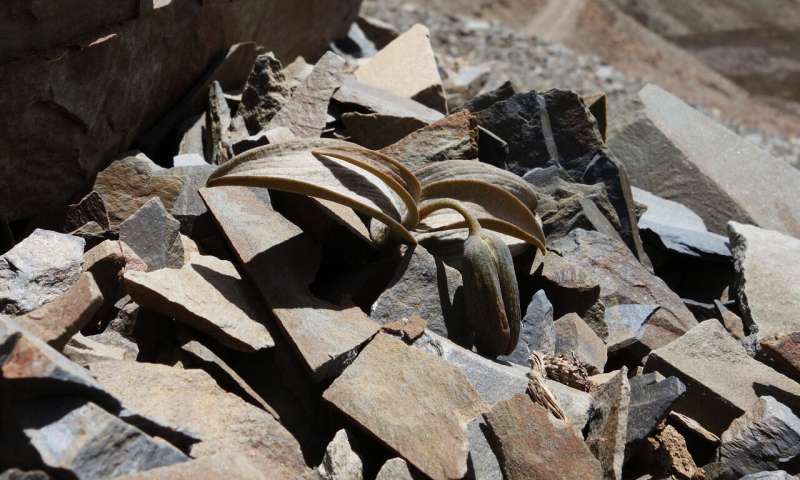Plant evolves to become less visible to humans

A plant used in traditional Chinese medicine has evolved to become less visible to humans, new research shows.
Scientists found that Fritillaria delavayi plants, which live on rocky slopes of China's Hengduan mountains, match their backgrounds most closely in areas where they are heavily harvested.
This suggests humans are "driving" evolution of this species into new colour forms because better-camouflaged plants have a higher chance of survival.
The study was carried out by the Kunming Institute of Botany (Chinese Academy of Sciences) and the University of Exeter.
"It's remarkable to see how humans can have such a direct and dramatic impact on the colouration of wild organisms, not just on their survival but on their evolution itself," said Professor Martin Stevens, of the Centre for Ecology and Conservation on Exeter's Penryn Campus in Cornwall.
"Many plants seem to use camouflage to hide from herbivores that may eat them—but here we see camouflage evolving in response to human collectors.
"It's possible that humans have driven evolution of defensive strategies in other plant species, but surprisingly little research has examined this."

In the new study, the researchers measured how closely plants from different populations matched their mountain environment and how easy they were to collect, and spoke to local people to estimate how much harvesting took place in each location.
They found that the level of camouflage in the plants was correlated with harvesting levels.
In a computer experiment, more-camouflaged plants also took longer to be detected by people.
Fritillaria delavayi is a perennial herb that has leaves—varying in colour from grey to brown to green—at a young age, and produces a single flower per year after the fifth year.

The bulb of the fritillary species has been used in Chinese medicine for more than 2,000 years, and high prices in recent years have led to increased harvesting.
"Like other camouflaged plants we have studied, we thought the evolution of camouflage of this fritillary had been driven by herbivores, but we didn't find such animals," said Dr. Yang Niu, of the Kunming Institute of Botany. "Then we realised humans could be the reason."
Professor Hang Sun, of the Kunming Institute of Botany, added: "Commercial harvesting is a much stronger selection pressure than many pressures in nature. "The current biodiversity status on the earth is shaped by both nature and by ourselves."
The paper, published in the journal Current Biology, is entitled: "Commercial harvesting has driven the evolution of camouflage in an alpine plant."
More information: Yang Niu et al, Commercial Harvesting Has Driven the Evolution of Camouflage in an Alpine Plant, Current Biology (2020). DOI: 10.1016/j.cub.2020.10.078 , dx.doi.org/10.1016/j.cub.2020.10.078
Journal information: Current Biology
Provided by University of Exeter




















